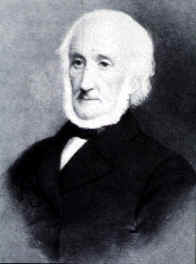George Petrie (antiquarian) facts for kids
Quick facts for kids
George Petrie
|
|
|---|---|

Portrait of Petrie, by Bernard Mulrenin
|
|
| Born | 1 January 1790 |
| Died | 17 January 1866 |
| Occupation | Painter, Antiquarian |
George Petrie (born January 1, 1790 – died January 17, 1866) was a talented Irish artist and a very important person in history. He was a painter, musician, and someone who studied old things (an antiquarian and archaeologist). He lived during the Victorian era. George Petrie helped build amazing collections for the Royal Irish Academy and the National Museum of Ireland.
Contents
Early Life and Art
George Petrie was born in Dublin, Ireland. He grew up at 21 Great Charles Street, near Mountjoy Square. His father, James Petrie, was a portrait painter from Scotland. George loved art from a young age.
He went to the Dublin Society's Schools to study art. At just 15 years old, in 1805, he won a silver medal for his artistic skills.
Petrie's Amazing Career
After a short trip to England, George Petrie returned to Ireland. He mostly created sketches for travel books. These books showed beautiful places like Killarney, Wicklow, and Dublin. His drawings helped people see what Ireland looked like.
Helping the Royal Irish Academy
In the late 1820s and 1830s, Petrie made a huge difference at the Royal Irish Academy. He was in charge of their old artifacts committee. He helped them get many important Irish writings. These included a special copy of the Annals of the Four Masters. He also helped them collect ancient metal items. These items included the famous Cross of Cong and the Roscrea Brooch.
Father of Irish Archaeology
Petrie wrote very important essays about old Irish buildings and history. His essay on the Round Towers of Ireland was published in 1845. This book was called The Ecclesiastical Architecture of Ireland. Because of his great work, people often call him "the father of Irish archaeology." His study of the tombs at Carrowmore is still used by researchers today.
Working with the Ordnance Survey
From 1833 to 1843, Petrie worked for the Irish Ordnance Survey. This group made detailed maps of Ireland. He led the part that studied old places. He worked with famous scholars like John O'Donovan and Eugene O'Curry.
Important Writings and Magazines
In 1834, Petrie wrote an essay about old Irish military buildings. It won a prize but was never published. However, his important essay On the History and Antiquities of Tara Hill was published in 1839. During this time, Petrie also edited two popular magazines. These were the Dublin Penny Journal and the Irish Penny Journal.
Collecting Irish Music
Another big thing Petrie did was collect Irish traditional songs. He published these in 1855 as The Petrie Collection of the Ancient Music of Ireland. An Irish pianist named J.J. Sheridan later recorded this collection.
Petrie had a special way of collecting music. He would listen to a singer and write down the Irish words. Then, he would carefully write down the notes of the melody. He often asked the singer to repeat parts until he got it just right.
Petrie as an Artist
As an artist, Petrie loved using watercolour paints. Back then, some people thought watercolour was not as good as oil painting. But Petrie was one of the best Irish Romantic painters of his time. You can see some of his best work at the National Gallery of Ireland. One famous painting is Gougane Barra Lake with the Hermitage of St Finbarr, Co. Cork (1831).
Awards and Recognition
The Royal Irish Academy gave Petrie their special Cunningham Medal three times. He won it in 1831 for his essay on round towers. He won again in 1834 for his essay on military buildings. Finally, he won in 1839 for his work on Tara Hill.
Images for kids
-
Portrait of Petrie, by Bernard Mulrenin




